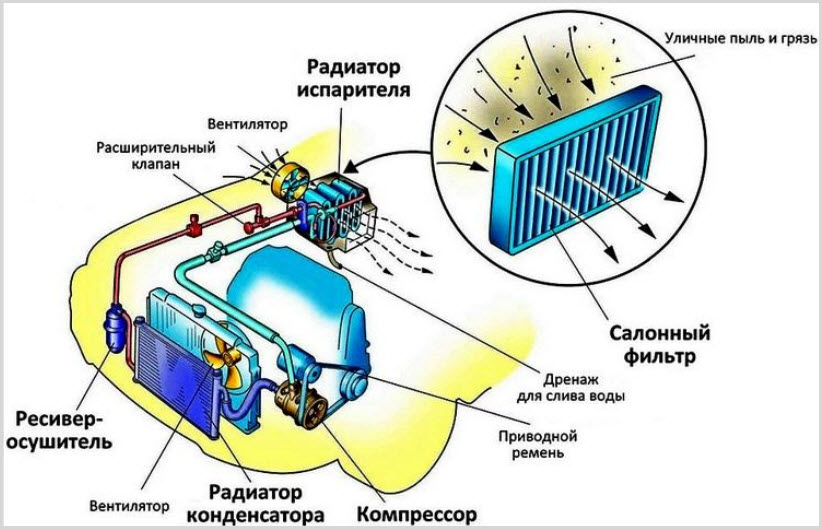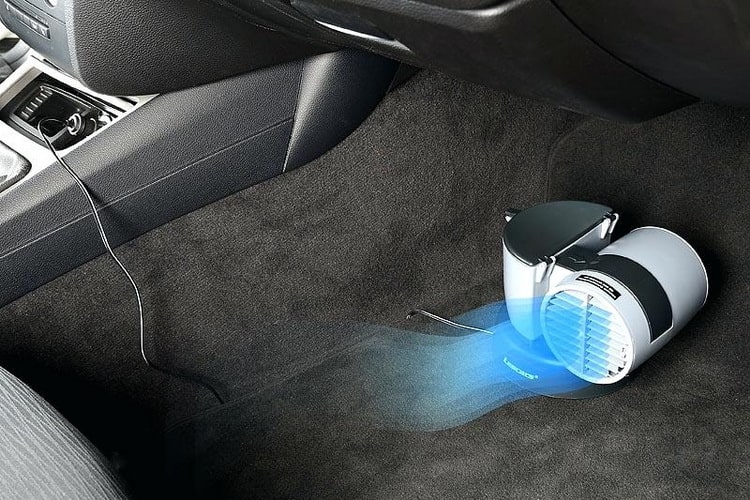
Autonomous air conditioners for a car: pros and cons
Content
Automotive air conditioning systems quickly took their place of honor in the use of car owners. Now, it’s hard to imagine a car without air conditioning, especially in the southern regions, but some old models in cheap trim levels do not have this option. Of course, everything can be installed, but there are not always plans for the long operation of an ancient car.

However, there are alternative options to alleviate the situation in the car in the heat, which will be discussed further.
How does an air conditioner work
The principle of operation for all compressor-type refrigeration units is more or less the same. It is based on the cooling of a pre-compressed refrigerant at the time of expansion.
A compressor is installed under the hood of the car, which is connected to the engine crankshaft pulley through an electromagnetic clutch and a drive belt.

When the air conditioner is turned on, the clutch closes, the compressor rotor begins to rotate and begins to compress the gaseous refrigerant, sending it through the pipeline to the radiator, also called the condenser.
From the name it is clear that the gas in the radiator condenses, lowering its temperature and turning into a semi-liquid state. Thus, it takes away the excess energy obtained during compression. After that, the liquefied gas enters the expander and evaporator, where its temperature drops to negative values.

The evaporator is made in the form of a heat exchanger between the refrigerant and the car interior air. As the gas expands and the radiator is blown, the temperature in the cabin drops.
Fans, sensors and air dampers regulate the process, providing a comfortable temperature set by the driver.
Often, the air conditioner is combined with a heater, forming an integrated climate control system, where the driver is not at all interested in what is working at the moment, the main thing is to maintain the specified thermal regime.
Automation itself will figure out whether to heat the air or cool it.
What is a portable air conditioner
If you do not consider the usual fan on the front panel, which is also capable of cooling a hot driver, then an autonomous air conditioner without deceit should not only direct the air flow to a person, but at least somehow cool this air.
There are several ways to do this, from the most primitive to the same ones that are used in a stationary climate control system.
Compressor air conditioners from the cigarette lighter
As a rule, all such devices are nothing more than a simple deception of the consumer. The air conditioner cannot work in a closed volume. He needs to dump the heat of the condenser into the surrounding space, otherwise he will not cool, but heat the interior in any mode of operation.


The exception is portable air conditioners, made on the principle of split systems. Most often they are mounted in a hatch on the cab roof.
In terms of complexity, such a device is practically no different from any other compressor-type automobile air conditioner, which can now be installed on any car, including the oldest domestic models.
At the same time, they do not require the operation of the main engine of the car, which has a positive effect on the environment in time, for example, overnight stays for truck drivers. Moreover, in many countries, the operation of the engine in the parking lot is prohibited by law.
As for the power supply from the cigarette lighter, the power of this circuit is very limited, and usually does not exceed 250 watts in continuous mode.
There is no need to talk about some kind of efficiency in cooling the interior of a car with such energy consumption.
In addition, the main advantage of autonomous systems in the form of the ability to work with a turned off engine is not realized due to the rapid discharge of the battery. The fact that for air conditioning will be a frivolous power, for the battery will be an prohibitive load.
Portable evaporative air conditioners
The simplest air cooling scheme is based on the principle of lowering the temperature of the liquid during its evaporation.


Such devices use a low-intensity water supply from a separate reservoir to an evaporator, which has a spongy structure, blown by an electric fan.
The air is simultaneously cooled and saturated with water vapor. High humidity in the cabin becomes the main disadvantage of this type of air conditioner.
In addition to the fact that in such conditions it is difficult for passengers to evaluate the effect of lowering the temperature, constant moisture will adversely affect the technical condition of the car, ranging from normal corrosion to the appearance of fungi in the finishing materials. And the temperature will drop only by a few degrees, and only near the fan.
What to Expect from a Mobile Air Conditioner
In any case, there can be no universality in the use of autonomous air conditioners. What is suitable for a truck is unacceptable for a passenger car.


A serious autonomous climate control system, and not a cheap market craft, still has certain advantages:
- independence from a specific car model will allow you to flexibly apply it on different cars;
- for the air conditioner to work, you do not need to start the car engine;
- subject to the provision of electricity, the autonomy can constantly maintain an acceptable interior temperature in the parking lot;
- the device operates relatively silently and does not pollute the atmosphere.
This is accompanied by significant disadvantages:
- as a rule, the power of autonomous installations is too small, and hence the efficiency;
- the high price of really working systems is comparable to regular climate control units;
- there are many fakes and outright fraud on the market;
- installations are difficult to apply for cars.
That is, such devices are acceptable only for trucks and all kinds of campers. And practically the problems of the microclimate in all passenger cars have long been resolved even in basic configurations.
How to make a mobile air conditioner in the car yourself
Fans of technical creativity will be able to create an analogue of an autonomous air conditioner on their own.
There can be a lot of options, so you should limit yourself to only general principles of construction. The basis of the design should be a container with ice reserves. Dry or it will be ordinary frozen water - it all depends on the possibilities of supplying a source of cold.
A blower electric fan and an outlet pipe are installed in the container, to which you can even connect a long corrugated hose, which makes it possible to conveniently place the unit in the cabin.


Watch this video on YouTube
When the fan is running, the air from the passenger compartment will pass through contact with ice, cool and enter the passenger compartment in this form. As the ice is consumed, its reserves can be replenished from a separate thermally insulated storage.
The installation is quite efficient, and in terms of manufacturing and operation costs it is out of competition.

